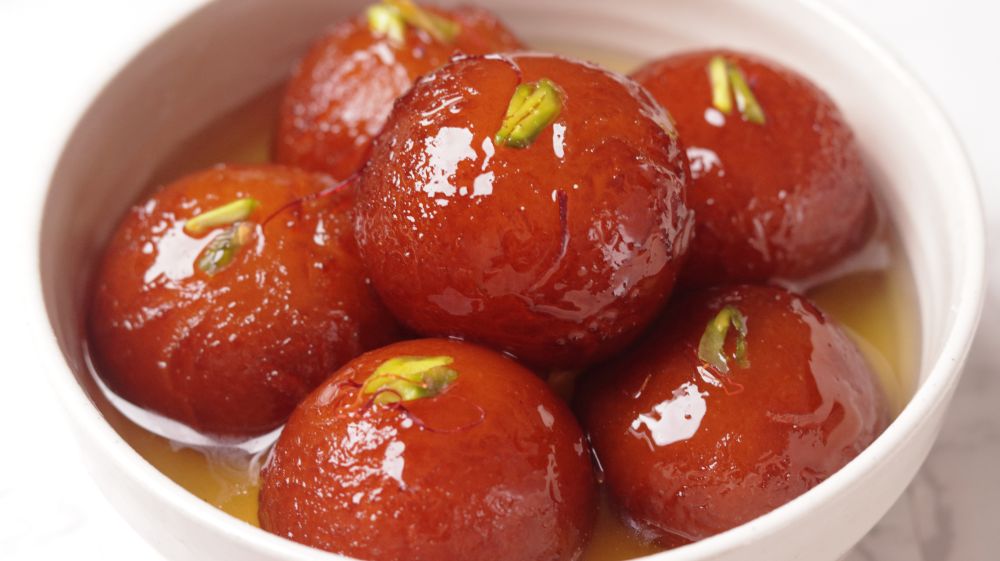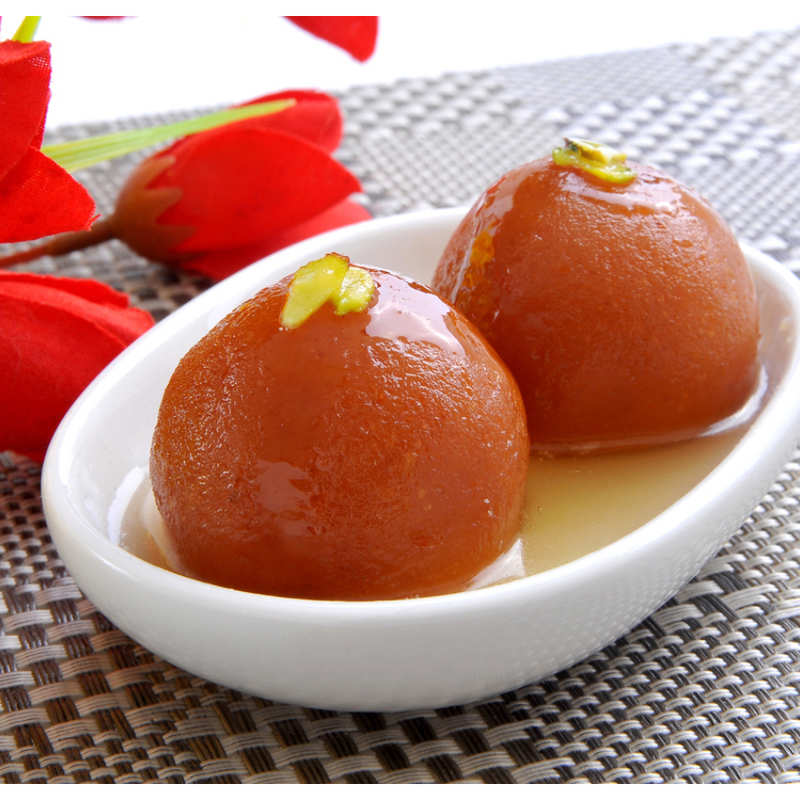The Indian Dessert - Gulab Jamun

Gulab Jamun is a popular and traditional Indian sweet that has a rich history and is enjoyed across the Indian subcontinent and beyond. The name "Gulab Jamun" is derived from two words: "Gulab," which means rose in Persian, and "Jamun," referring to a dark purple fruit similar in size and shape to the sweet. The name reflects the dessert's round and brown appearance, resembling the jamun fruit.

The exact origins of Gulab Jamun are unclear, but it is believed to have its roots in Persian or Arabic sweets that were introduced to India during the medieval period. These sweets were adapted and evolved over time to suit local tastes and ingredients.
Gulab Jamun is made from khoya (reduced milk solids), which is kneaded into a soft dough and then shaped into small balls. These balls are deep-fried until they achieve a golden brown color, giving them a crispy exterior. The fried balls are then soaked in a sugar syrup flavored with rose water, cardamom, or saffron, imparting a sweet and aromatic taste.
Over the years, Gulab Jamun has become an integral part of Indian cuisine, especially during festive occasions like Diwali, weddings, and other celebrations. It is often served warm, and its delectable taste and texture make it a favorite among people of all ages.
Gulab Jamun has also gained popularity in other South Asian countries and has variations in preparation methods and ingredients across the region. Whether homemade or purchased from sweet shops, Gulab Jamun remains a beloved dessert, symbolizing sweetness and joy in many cultural celebrations.
Gulab Jamun Recipe;
Ingredients:
For Gulab Jamun Balls:
- 1 cup khoya (milk solids)
- 1/4 cup all-purpose flour (maida)
- 1/4 cup paneer (optional)
- A pinch of baking soda
- 2 tablespoons ghee (clarified butter)
- Milk (as needed to knead the dough)
For Sugar Syrup:
- 1 cup sugar
- 1 cup water
- 1/2 teaspoon cardamom powder
- A few saffron strands (optional)
- 1 teaspoon rose water
For Deep Frying:
- Ghee or oil for deep frying
Instructions:
- Prepare the Gulab Jamun Dough:
- Grate or crumble the khoya into a mixing bowl.
- Add all-purpose flour, baking soda, and ghee to the khoya.
- If using paneer, grate it and add it to the mixture.
- Mix well to form a soft, smooth dough. If the dough is too dry, add a little milk gradually until it comes together.
- Shape the Gulab Jamun Balls:
- Take small portions of the dough and roll them into smooth, crack-free balls. Ensure they are uniform in size for even cooking.
- Prepare the Sugar Syrup:
- In a saucepan, combine sugar and water to make the sugar syrup.
- Bring it to a boil, stirring until the sugar dissolves.
- Add cardamom powder and saffron strands (if using).
- Simmer the syrup for 5-7 minutes until it slightly thickens.
- Add rose water and turn off the heat.
- Deep Fry the Gulab Jamun Balls:
- Heat ghee or oil in a pan over medium heat.
- Fry the Gulab Jamun balls on low to medium flame until they turn golden brown, turning them gently to ensure even cooking.
- Once done, remove excess oil by placing the fried balls on a paper towel.
- Soak in Sugar Syrup:
- Place the fried Gulab Jamun balls into the warm sugar syrup.
- Allow them to soak for at least 2-3 hours, ensuring they absorb the syrup and become soft.
- Serve:
- Garnish with chopped nuts if desired.
- Serve Gulab Jamun warm, and enjoy this delightful sweet!
This recipe yields delicious and melt-in-the-mouth Gulab Jamun that you can prepare for festivals, celebrations, or whenever you crave a sweet treat.
Gulab Jamun Recipe Videos:
Gulab Jamun with Milk Powder Recipe;
Tips for Soft & Perfect Gulab Jamun;
Gulab Jamun Recipe with Homemade Instant Mix;
References;
- Marty Snortum, Lachu Moorjani (2005). Ajanta: regional feasts of India. Gibbs Smith. p. 17. ISBN 1-58685-777-0.
- shraddha.bht. "Gulab Jamun". Konkani Recipes. Retrieved 25 May 2010.
- Michael Krondl (2011). Sweet Invention: A History of Dessert. Chicago Review Press. p. 7-8. ISBN 978-1-55652-954-2. In another recipe he gives directions for a syrup-soaked fritter many modern Indians would recognize. To make it, the cook is told to curdle warm milk by adding buttermilk, then strain it to remove the liquid. (Nowadays this fresh cheese would be called chhana.) The resulting curds are then mixed with a little rice flour, formed into balls, and fried in ghee. Finally, they are soaked in syrup.
- Michael Krondl (1 June 2014). The Donut: History, Recipes, and Lore from Boston to Berlin. Chicago Review Press. pp. 7–8. ISBN 978-1-61374-673-8. To make it, you form balls out of a dough of fresh cheese curds mixed with rice flour, fry these in ghee, and then soak them in cardamom-scented syrup. I imagine the king feeding the morsels—tender, buttery, and dripping with the perfumed syrup—to his favorite as she lies resplendent on a silk-lined bed. Most of these fritters still exist and in more than one variation.
- Michael Krondl (2011). Sweet Invention: A History of Dessert. Chicago Review Press. p. 38. ISBN 978-1-55652-954-2. A fitters of very similar appearance is made in the Middle East under the name Luqmat Al Qadi. It is conceivable that they both developed from an earlier Persian antecedent. Gulab comes from the Persian word for rosewater, while Jamun refers to a local fruit of roughly this size. The two batters are made entirely differently, though, so the only Persian connection may be the common use of rosewater syrup.
Thank you for sharing your time!
You can complete great comment tasks at here. #dessert #sweet #indian #cooking #cuisines #foodinspiration #food #chefs
























































